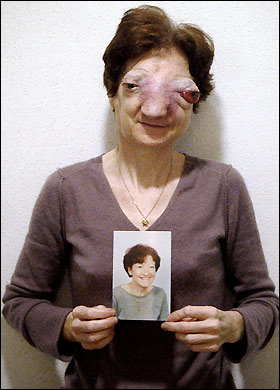A consideration of Chantal Sebire’s imminent death and the kindness of a seeming cruelty.

Chantal Sebire was a 52 year old teacher and mother of three. In March 2008, she submitted an application to the court in Dijon, France for her physician to withhold all treatment on her which would allow her to die. She suffered from an extremely rare and disfiguring form of cancer called esthesioneuroblastoma – an incurable tumor attacking her nasal and sinus cavity that had left her severely disfigured, unable able to see properly, no sense of smell or taste, and suffered severe constant pain – physically and emotionally. Ms. Sebire even appealed on television in France, describing of children running away from her. She said, “One would not have allowed an animal to go through what I have endured.”
What she was asking for was merely for her suffering to end and for her to die in dignity, in which, it should be a right that every human being is entitled to. That is the essence of her request. In a more technical term, she was asking for ‘euthanasia’ – a term that has sparked endless debate.
Should or should not, the court have granted her her request?
First let us explore the definition of the term ‘euthanasia’. There are various types of euthanasia.
- Voluntary euthanasia is one that is carried out with competent consent and upon request from the patient.
- Non-voluntary euthanasia is the type which the patient is incapable of expressing his or her wish, for example, a patient in a comatose state.
- Involuntary euthanasia, on the other hand, is performed against the wish of the patient.
In Malaysia, euthanasia is illegal. According to Section 306 of the Penal Code, assistance to end one’s life is an offence punishable up to 10 years imprisonment. In England, even though Anthony Bland became the first patient who was allowed by the House of Lords to die with dignity by removing his life support system in 1993, euthanasia has subsequently still remain illegal in the United Kingdom when the Assisted Dying for the Terminally Ill Bill failed to be passed in 2004 and also in cases involving UK citizens brought to the European Court of Human Rights, such as Pretty v the UK and the latest case of Glass v the UK. However, it should be noted that in the latter case, the Court held that in overriding the applicant’s objection to proposed treatment on her child, David Glass, there is a violation of Article 8 of the European Convention of Human Rights. In other words, can we say that opposing a patient’s wish to die is a violation as well?
Arguments against the decriminalization of euthanasia has always centered upon Right to Life, which was guaranteed through the Universal Declaration of Human Rights (UDHR) in 1948 and subsequently in the International Covenant for Civil and Political Rights (ICCPR) in 1966. Both instruments guarantee each individual freedom from attack of their life, dignity and property. Words occur in the preamble and relevant articles of the UDHR and ICCPR, such as, ‘inalienable’, ‘inherent’, and ‘equal’ signifies that this right is granted to all persons and shall be respected irrespective of circumstance or preference.
However, shouldn’t Right to Life, operate in the same way as right to die? Just as everyone has an inherent Right to Life, surely everyone should be entitled to the right to die as well? The Right to Life guarantees freedom from attack on one’s life, dignity, and property. Where is the dignity of patients such as Dianne Pretty and Karen Ann Quinlan who died under the conditions which they specifically didn’t want to, after they repeatedly request for their suffering to be put to an end? Explicitly denying one’s request to end their life so that their suffering can be brought to an end, does that not amount to inhumane conduct?
No one is, and should be advocating, for involuntary euthanasia to be decriminalized, because no one should be killed against their wish, just as no one should be forced to live a life which they do not want to live. Perhaps it is more accurate to put it this way – no one shall be forced to live a life, in which there is no life to be lived. This essentially brings us to the debate of value of life versus existence of life. Euthanasia shall be allowed in cases where the patient is deemed to only exist as a human organism as opposed to a human person. Or as one of the judges in the case of Tony Bland, put it – a “shell” which his soul has already flown away. In circumstances like that, the patients are not asking for their life to end because they see no value in life or that life is not worth living; but because there is no life to be lived at all.
Ms. Sebire was found dead of an overdose two days after the court in France rejected her request.
How many Chantal Sebire do there need to be before we learn a little bit of humanity?

Samuel, wouldn't visiting the doctor, getting cut open and sewn back by a surgeon, pumped a cocktail of man made drugs directly into one's veins, willfully getting exposed to radiation, all an intervention to 'life's natural course' already?
LET LIFE RUN ITS NATURAL COURSE
When we believe that all lives belong to God
We'll want all lives to take their natural course
Without us in any way or manner try to play God
Although this may not be accepted by all of course
(C) Samuel Goh Kim Eng – 060210
http://MotivationInMotion.blogspot.com
Sat. 6th Feb. 2010.